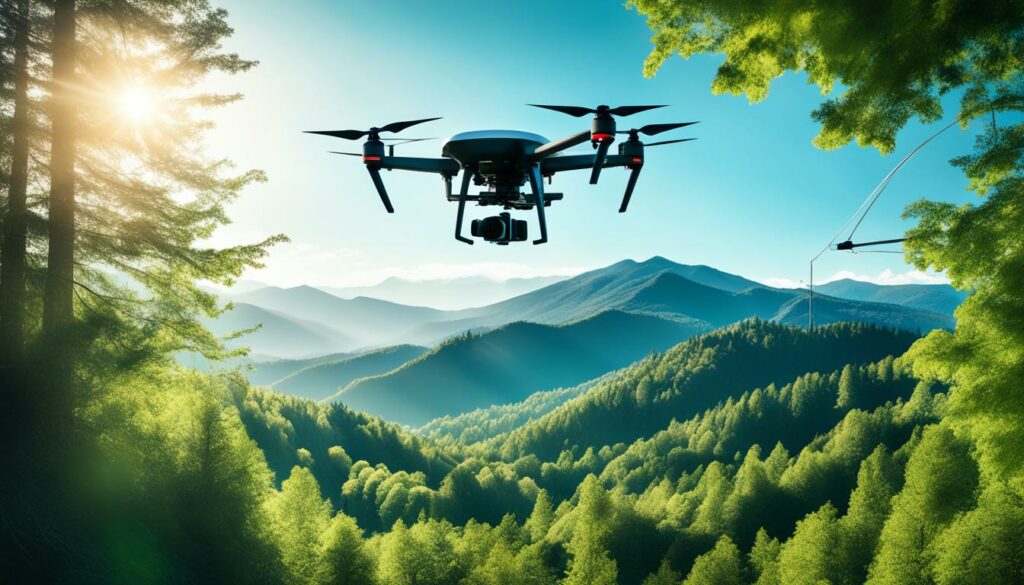Did you know our world is facing a triple crisis with climate change, losing biodiversity, and pollution? This situation calls for new solutions. AI in environmental monitoring is changing the game by offering a smarter way to protect our planet. Groups like the UN Environment Program (UNEP) are using AI to turn data into useful insights.
This helps us deal with big challenges better. For example, UNEP’s World Environment Situation Room, started in 2022, brings together data on important things like CO2 levels and glacier changes. This lets us analyze the environment in real-time and make predictions.
With over 900 satellites watching Earth and AI tools managing resources, we’re moving towards a sustainable future. This is a big step forward.
Key Takeaways
- AI enables real-time analysis of environmental data, transforming decision-making processes.
- UNEP’s World Environment Situation Room curates critical datasets for predicting environmental changes.
- Over 900 satellites, supported by ground sensors, provide invaluable information for AI analysis.
- AI contributes significantly to biodiversity conservation, aiding in the identification of endangered species.
- AI technologies streamline compliance monitoring, reducing administrative burdens for organizations.
Understanding AI and Its Role in Environmental Monitoring
Artificial intelligence has changed many fields, and it’s big in environmental monitoring too. It helps us understand ecosystems better. This leads to better ways to protect our planet.
Defining Artificial Intelligence
Artificial intelligence means systems that think and act like humans, like understanding data and making choices. Thanks to AI, we get a deeper look at how the environment works. Studies show AI can spot pollution with over 600% better accuracy than guessing.
This skill is key in making sure companies follow environmental laws. It helps keep everyone accountable.
The Concept of Environmental Monitoring
Environmental monitoring is about watching and recording how the environment changes. It’s crucial for spotting trends and understanding the big picture. With new tech, including AI, we can make monitoring better.
For example, AI helps track how climate change affects the planet and checks on our progress towards being more sustainable. AI looks at lots of data quickly and helps make fast, smart decisions. This has a big effect on making policies and keeping communities healthy.
AI in Environmental Monitoring: Key Applications
Artificial Intelligence is changing how we monitor the environment. It makes tracking wildlife and protecting their homes better. It also helps us make smart choices in conservation.
Wildlife Tracking and Conservation
AI is key in tracking wildlife. It uses advanced algorithms to analyze data from GPS collars, camera traps, and drones. This helps us know which animals are where and how many there are.
It also helps stop poachers by sending alerts in real-time. This way, we can track animals and protect them better.
- Enhanced species identification using AI-driven image and data analysis.
- Real-time tracking of endangered species to improve conservation strategies.
- Integration of machine learning to analyze environmental impacts on wildlife behavior.
Habitat Assessment Innovations
AI is also changing how we assess habitats. It uses images to spot changes in the land. This helps researchers see deforestation, check forest health, and find areas that need help.
| Aspect | Traditional Methods | AI Innovations |
|---|---|---|
| Data Collection | Manual survey methods | Automated image recognition from drones and satellites |
| Analysis Speed | Time-consuming | Real-time analysis |
| Accuracy | Subject to human error | High precision through algorithm validation |
| Scalability | Limited by resources | Scalable with cloud computing capabilities |
These AI insights help us understand how habitats change. They support better ways to protect nature.
Leveraging AI Technology for Enhanced Data Analysis
AI technology for environmental monitoring greatly improves how we analyze data in real-time. This lets organizations make better decisions. AI can quickly go through a lot of information. It gives insights into the environment, helping us act fast when things change.
Real-Time Data Processing and Decision Making
AI makes it possible to process data as it happens, which is key for making good environmental decisions. It looks at data from many sources like satellites and ground sensors. This makes decisions quicker. Authorities can quickly react to things like pollution or natural disasters, making their efforts more effective.
Take Google’s Project Sunroof as an example. It uses AI to monitor the environment and has installed over 3 GW of solar capacity. This has also stopped millions of tons of CO2 emissions each year. This shows how AI and advanced analytics can help manage the environment better.
Real-time analysis helps spot trends and oddities in environmental data fast. For example, AI can make wind farms up to 20% more efficient, according to the International Renewable Energy Agency. In farming, AI helps use water wisely, cutting down usage by 30% and boosting crop yields. This highlights AI’s role in managing resources well.
As AI gets better, its use in monitoring the environment will expand. It can handle complex data sets, helping us tackle environmental issues early. This leads to smarter decisions and a more sustainable future.
Smart Environmental Monitoring Systems in Action
More and more, global efforts are using smart environmental monitoring systems with AI. These systems change how we watch and deal with environmental problems. They help us make quick decisions and act wisely.
Global Initiatives Utilizing AI Solutions
Big projects show how AI helps with environmental monitoring. The United Nations Environment Programme tracks methane emissions with smart systems. This gives real-time data to help fight climate change.
The GEMS Air Pollution Monitoring platform is another great example. It uses data from over 25,000 stations worldwide. This info helps make health and pollution control plans.
Case Studies: Successful AI Implementations
Many case studies show how AI works well in environmental monitoring. Microsoft’s AI for Earth program works with groups to use AI in farming, saving nature, and fighting climate change. These examples show how AI can help make the environment better.
Below is a table with some key projects:
| Initiative | Focus Area | Technology Used | Outcomes |
|---|---|---|---|
| UNEP Methane Emissions Observatory | Methane Tracking | Real-Time Monitoring Systems | Improved Policy Decisions |
| GEMS Air Pollution Monitoring | Air Quality | Global Sensor Networks | Health Protection Insights |
| Microsoft AI for Earth | Various Ecosystems | AI and Machine Learning | Sustainable Practices Enhancement |

Environmental Monitoring AI Solutions for Pollution Control
AI solutions are key in fighting pollution, especially with environmental monitoring AI. These tech tools use smart algorithms and sensors to track air quality closely. By adding machine learning, they make air and water quality checks 80% more accurate.
These AI systems cut costs by 40% compared to manual checks. They also make gathering data faster and easier.
AI for pollution control is great at mixing different data types from PM sensors. It can handle over 15 types of data, showing its flexibility. The software uses 10 different machine learning models to analyze data. This gives a deep look into pollution sources and trends.
These AI tools are 90% accurate in finding pollution sources on maps. This is crucial for local governments and agencies to target pollution well. They can now predict air and water quality 75% better than before, helping in early action.
| Feature | Statistic |
|---|---|
| Accuracy Improvement in Quality Analysis | 80% |
| Cost Reduction in Testing | 40% |
| Data Input Formats Integrated | 15 |
| Machine Learning Models Used | 10 |
| Source Identification Accuracy | 90% |
| Future Prediction Improvement | 75% |
| Categories of Technology | 4 |
Advanced AI for environmental monitoring is tackling growing pollution and the need for new ways to manage it. These platforms use the latest tech, like sensor networks and satellite images. They help track pollution and solve problems with data and insights.
These technologies work with humans to manage the environment sustainably. They get communities involved in checking water and air quality. This tech goes beyond just collecting data, affecting public health and the environment.
For more on AI’s impact, check out how it’s changing finance and trading at AI in financial services.
The Benefits of AI in Environmental Monitoring
Using AI in environmental monitoring has many advantages. It makes old methods more efficient and accurate. Both organizations and governments use AI to improve their work.
Enhanced Accuracy and Efficiency
AI makes environmental monitoring more precise by quickly analyzing large amounts of data with advanced algorithms. It gives real-time updates on air quality, animal movements, and other environmental factors. This leads to faster and better decisions.
This enhanced accuracy cuts down on human mistakes. It helps track environmental changes and challenges more effectively.
Cost-Effectiveness in Surveillance and Management
AI-driven solutions save a lot of money in surveillance and managing the environment. Automated systems work well with little help from humans. This lowers labor costs and boosts how much work can be done.
For example, AI helps in managing water by tracking usage, predicting needs, and optimizing distribution. This saves water and makes these processes more efficient. By making these changes, groups can do more with less money in their green efforts.

AI-Driven Environmental Data Analysis
AI-driven environmental data analysis uses advanced tech to turn big datasets into useful insights. It helps many sectors, like manufacturing, make better decisions. This leads to better environmental performance and sustainability.
Predictive analytics is key in spotting potential equipment failures. This lets industries plan maintenance ahead, cutting down on downtime and waste. With AI, facilities can keep an eye on things like energy use, waste, and emissions. This helps make operations more efficient.
Using AI algorithms with current processes is crucial for getting the most out of this tech. Sensors for data collection help with constant monitoring. This is important for quick action. Training plant managers in AI helps the team use these tools well.
AI can also analyze satellite images for environmental monitoring. It quickly spots changes in land use, identifies species in images, and predicts which species might be at risk. This helps a lot with studying biodiversity.
As more industries use AI for environmental monitoring, they improve how they follow rules and use resources wisely. AI makes it possible for real-time checks and actions. This could change how companies deal with their environmental impact, helping them meet sustainability goals.
Environmental Monitoring Using AI Algorithms
AI algorithms have changed how we monitor the environment. They use predictive analytics to predict and analyze climate changes. This helps us make better decisions for protecting the environment. By using data from many sources, AI gives us insights that help us act before problems happen.
Predictive Analytics for Climate Changes
Predictive analytics helps us forecast climate events accurately. For example, machine learning models are very good at predicting climate changes. They have an R-squared value of 0.85 and a Mean Squared Error (MSE) of 2863.16.
This means they can predict things like where invasive species might spread or how climate change will affect certain areas. AI can even tell the difference between natural sounds in forests and sounds made by humans. This helps us understand how healthy our ecosystems are.
Integration of Diverse Data Streams
Combining different types of data is key to effective environmental monitoring with AI. By using data from satellites, sensors, and past records, we can track things like air and water quality, soil health, and the variety of life in an area. AI can take in real-time data from many sensors to check on the environment.
AI also lets us look at changes in land use, habitat loss, and deforestation through satellite images. This way, we can spot environmental risks and find chances to act.
| Feature | Description | Benefits |
|---|---|---|
| Predictive Analytics | Models future environmental changes based on historical data. | Allows for proactive conservation measures. |
| Diverse Data Streams Integration | Combines data from satellites, sensors, and social media. | Offers comprehensive insights on environmental conditions. |
| Real-Time Monitoring | Processes data instantaneously to assess environmental factors. | Facilitates immediate decision-making and response. |
| Machine Learning Accuracy | Aligns predictions with actual values effectively. | Increases reliability in environmental assessment. |
| Citizen Science Engagement | Empowers individuals through AI platforms for data contribution. | Enhances community involvement and data richness. |
Challenges and Future Directions in AI for Environmental Monitoring
AI is changing many areas, but using AI in environmental monitoring has big hurdles. These include algorithmic bias, data quality problems, and the need for strong policies. These policies must ensure AI is used fairly and ethically.
Algorithmic Bias and Data Quality Issues
Algorithmic bias comes from bad or incomplete data, which can wrongly show environmental conditions. For example, if data collection only looks at some areas or species, AI might give wrong results. This can hurt conservation efforts.
Having good data is key. Bad or biased data can lead to wrong environmental plans. To make AI better at monitoring nature, we need to focus on high-quality data. We also need clear and open ways to collect data.
Policy and Ethical Considerations
Setting clear policies is vital for using AI in the environment responsibly. These policies should cover data privacy, security, and how algorithms work. This helps avoid misuse risks.
Thinking about ethics is also crucial. We need to make sure AI helps everyone equally. It should be available to all communities. With the right rules, we can build trust and work together on using AI in nature.
Conclusion
AI in environmental monitoring is a key step forward in tackling our big ecological problems. It uses AI technology to make things more accurate and efficient. This changes how we collect and look at environmental data.
In fields like manufacturing and mining, AI gives us real-time insights. It helps make better decisions that are good for the environment. This leads to better outcomes for our planet.
AI can also predict environmental issues and talk to people in a new way. This helps us work towards a greener future. It can cut down on energy use, reduce emissions, and help manage waste better.
But, using AI in environmental monitoring comes with its own set of challenges. We need to think about ethics, being open, and keeping data safe. Working together is key to solving these issues and making the most of AI.
By investing in AI, we can make a big step towards a sustainable future. Learn more about how AI is changing education and the.
FAQ
What is AI in environmental monitoring?
AI in environmental monitoring uses artificial intelligence to analyze data efficiently. It helps identify trends and make decisions for ecological management. Advanced algorithms work with large datasets from various sources for effective monitoring.
How does artificial intelligence help in wildlife tracking?
AI improves wildlife tracking with advanced algorithms. These analyze GPS data, camera traps, and drone images. This helps in identifying species, counting populations, and fighting poaching, which helps protect biodiversity.
What are the benefits of using AI solutions for pollution control?
AI helps control pollution by monitoring air quality in real-time and predicting trends. It gives insights for managing pollution’s effects on ecosystems and health. This leads to better environmental health and cleaner air in cities.
Can AI improve the efficiency of environmental monitoring processes?
Yes, AI makes environmental monitoring more efficient. It offers fast and reliable analytics, automating data collection and analysis. This saves labor hours and reduces costs.
What role do predictive analytics play in environmental monitoring using AI?
Predictive analytics with AI models and forecasts climate events by analyzing past data and various sources. This helps policymakers make informed decisions on environmental risks and opportunities for action.
What challenges does AI face in environmental monitoring?
AI faces challenges like algorithmic bias from poor data quality and biased data collection. Ensuring high-quality data and ethical AI use is key to overcome these issues and ensure fair technology access.
How are organizations like UNEP utilizing AI for environmental care?
Groups like the UN Environment Program use AI in projects like the World Environment Situation Room and the International Methane Emissions Observatory. These platforms use AI to monitor data, offer real-time insights, and guide policy decisions.
What advancements are being made with smart environmental monitoring systems?
Smart systems use AI to combine data from many sources for detailed insights. Platforms like the GEMS Air Pollution Monitoring system provide health protection measures and support proactive environmental management worldwide.
How does AI support habitat assessments?
AI helps in habitat assessments by analyzing images to detect deforestation, check forest health, and find areas for restoration. This technology is crucial for protecting ecosystems and managing resources.
What is the significance of data-driven insights in environmental management?
Data-driven insights are key for effective environmental management. They help stakeholders see patterns and trends in large datasets. This supports better policy-making and strategies to tackle environmental challenges.




